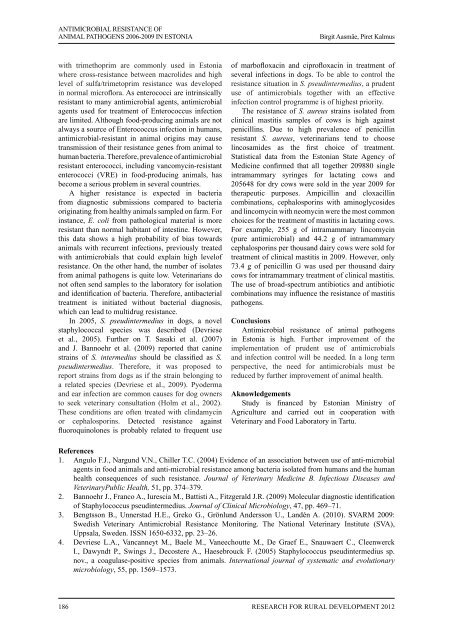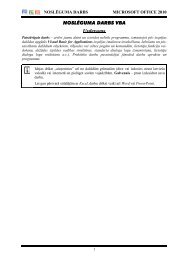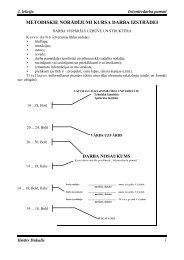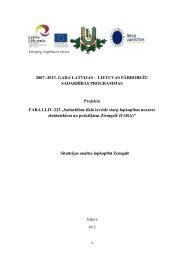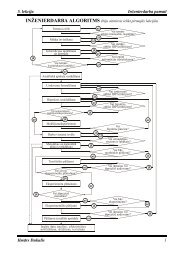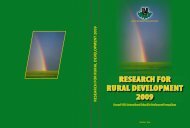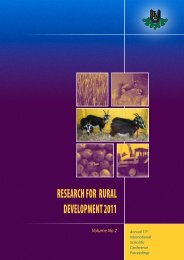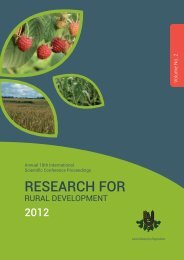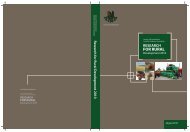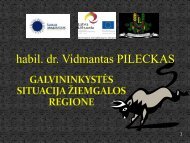LATVIA UNIVERSITY OF AGRICULTURE - Latvijas ...
LATVIA UNIVERSITY OF AGRICULTURE - Latvijas ...
LATVIA UNIVERSITY OF AGRICULTURE - Latvijas ...
- No tags were found...
You also want an ePaper? Increase the reach of your titles
YUMPU automatically turns print PDFs into web optimized ePapers that Google loves.
ANTIMICROBIAL RESISTANCE <strong>OF</strong>ANIMAL PATHOGENS 2006-2009 IN ESTONIABirgit Aasmäe, Piret Kalmuswith trimethoprim are commonly used in Estoniawhere cross-resistance between macrolides and highlevel of sulfa/trimetoprim resistance was developedin normal microflora. As enterococci are intrinsicallyresistant to many antimicrobial agents, antimicrobialagents used for treatment of Enterococcus infectionare limited. Although food-producing animals are notalways a source of Enterococcus infection in humans,antimicrobial-resistant in animal origins may causetransmission of their resistance genes from animal tohuman bacteria. Therefore, prevalence of antimicrobialresistant enterococci, including vancomycin-resistantenterococci (VRE) in food-producing animals, hasbecome a serious problem in several countries.A higher resistance is expected in bacteriafrom diagnostic submissions compared to bacteriaoriginating from healthy animals sampled on farm. Forinstance, E. coli from pathological material is moreresistant than normal habitant of intestine. However,this data shows a high probability of bias towardsanimals with recurrent infections, previously treatedwith antimicrobials that could explain high levelofresistance. On the other hand, the number of isolatesfrom animal pathogens is quite low. Veterinarians donot often send samples to the laboratory for isolationand identification of bacteria. Therefore, antibacterialtreatment is initiated without bacterial diagnosis,which can lead to multidrug resistance.In 2005, S. pseudintermedius in dogs, a novelstaphylococcal species was described (Devrieseet al., 2005). Further on T. Sasaki et al. (2007)and J. Bannoehr et al. (2009) reported that caninestrains of S. intermedius should be classified as S.pseudintermedius. Therefore, it was proposed toreport strains from dogs as if the strain belonging toa related species (Devriese et al., 2009). Pyodermaand ear infection are common causes for dog ownersto seek veterinary consultation (Holm et al., 2002).These conditions are often treated with clindamycinor cephalosporins. Detected resistance againstfluoroquinolones is probably related to frequent useof marbofloxacin and ciprofloxacin in treatment ofseveral infections in dogs. To be able to control theresistance situation in S. pseudintermedius, a prudentuse of antimicrobials together with an effectiveinfection control programme is of highest priority.The resistance of S. aureus strains isolated fromclinical mastitis samples of cows is high againstpenicillins. Due to high prevalence of penicillinresistant S. aureus, veterinarians tend to chooselincosamides as the first choice of treatment.Statistical data from the Estonian State Agency ofMedicine confirmed that all together 209880 singleintramammary syringes for lactating cows and205648 for dry cows were sold in the year 2009 fortherapeutic purposes. Ampicillin and cloxacillincombinations, cephalosporins with aminoglycosidesand lincomycin with neomycin were the most commonchoices for the treatment of mastitis in lactating cows.For example, 255 g of intramammary lincomycin(pure antimicrobial) and 44.2 g of intramammarycephalosporins per thousand dairy cows were sold fortreatment of clinical mastitis in 2009. However, only73.4 g of penicillin G was used per thousand dairycows for intramammary treatment of clinical mastitis.The use of broad-spectrum antibiotics and antibioticcombinations may influence the resistance of mastitispathogens.ConclusionsAntimicrobial resistance of animal pathogensin Estonia is high. Further improvement of theimplementation of prudent use of antimicrobialsand infection control will be needed. In a long termperspective, the need for antimicrobials must bereduced by further improvement of animal health.AknowledgementsStudy is financed by Estonian Ministry ofAgriculture and carried out in cooperation withVeterinary and Food Laboratory in Tartu.References1. Angulo F.J., Nargund V.N., Chiller T.C. (2004) Evidence of an association between use of anti-microbialagents in food animals and anti-microbial resistance among bacteria isolated from humans and the humanhealth consequences of such resistance. Journal of Veterinary Medicine B. Infectious Diseases andVeterinaryPublic Health, 51, pp. 374–379.2. Bannoehr J., Franco A., Iurescia M., Battisti A., Fitzgerald J.R. (2009) Molecular diagnostic identificationof Staphylococcus pseudintermedius. Journal of Clinical Microbiology, 47, pp. 469–71.3. Bengtsson B., Unnerstad H.E., Greko G., Grönlund Andersson U., Landén A. (2010). SVARM 2009:Swedish Veterinary Antimicrobial Resistance Monitoring. The National Veterinary Institute (SVA),Uppsala, Sweden. ISSN 1650-6332, pp. 23–26.4. Devriese L.A., Vancanneyt M., Baele M., Vaneechoutte M., De Graef E., Snauwaert C., CleenwerckI., Dawyndt P., Swings J., Decostere A., Haesebrouck F. (2005) Staphylococcus pseudintermedius sp.nov., a coagulase-positive species from animals. International journal of systematic and evolutionarymicrobiology, 55, pp. 1569–1573.186 Research for Rural Development 2012


